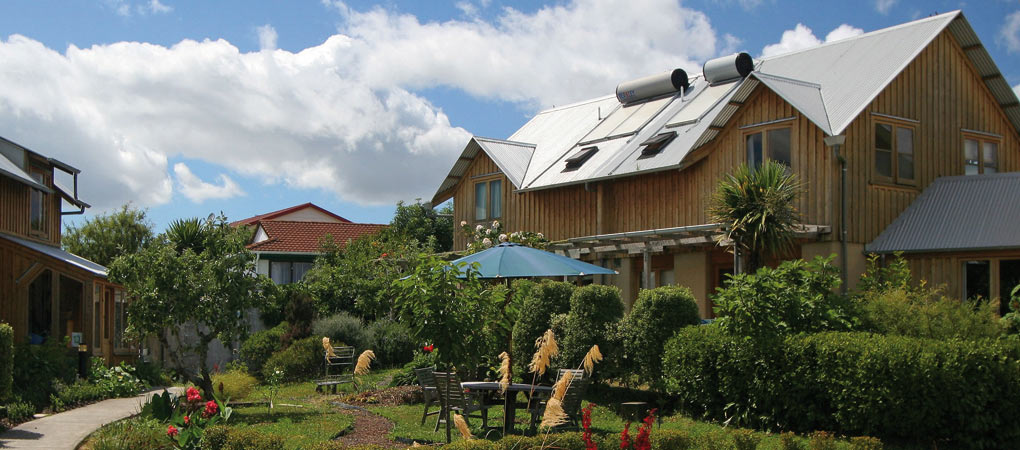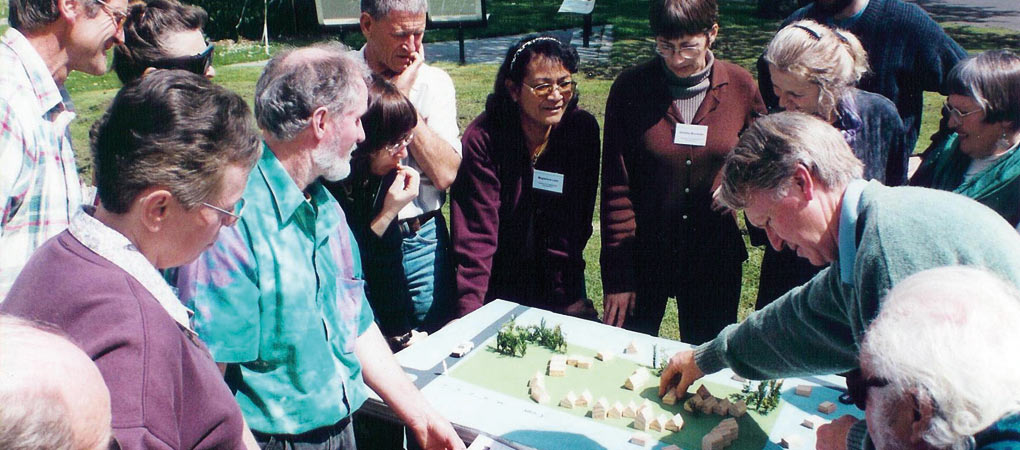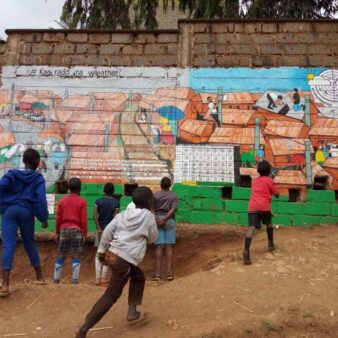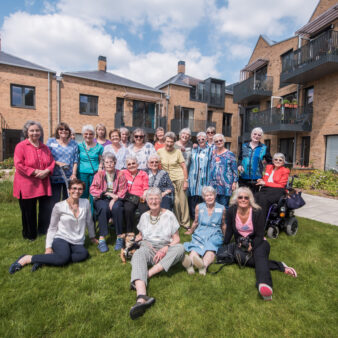The Earthsong Eco-Neighbourhood is the first cohousing community in New Zealand and combines environmentally-sustainable approaches to housing and lifestyle with well established community decision-making processes. The 32 households, made up of residents of all ages and a range of ethnic groups and economic circumstances, each have a self-contained home and also own and share extensive communal facilities with the community as a whole. Twice weekly communal meals, the vegetable garden, shared childcare and carpooling foster an atmosphere of respect and cooperation. Earthsong is an active member of its surrounding community and works in partnership with the local and national government to demonstrate and showcase the practical application of sustainable design principles.
Project Description
Aims and Objectives
Earthsong Eco-Neighbourhood was established, based on the principles of permaculture, to serve as a model of a socially- and environmentally-sustainable community. It aims to assist in education and increasing public awareness of social and environmental sustainability by demonstrating and promoting innovative community design and environmentally responsible construction.
Context
In New Zealand, conventional patterns of towns, suburbs and neighbourhoods promote both isolation and high resource use. With a poorly developed public transport system, most people need to use their cars to reach shops, schools and workplaces. This not only has negative environmental consequences, but also reduces interaction and interdependence between neighbours. The prevailing culture of individualism has led to a corresponding feeling of isolation and alienation by many people living without the support they really need, including single people, young families, older people and others. In addition, standard New Zealand house design, construction materials and services pay little regard to minimising the negative impacts on the environment. There has been much information and knowledge in the building industry for many years about how to build more energy efficient, environmentally responsible housing but examples of this information being used in practice have been rare in New Zealand.

Key features
Earthsong Eco-Neighbourhood is a 32-home cohousing neighbourhood on 1.29 hectares of land in the Auckland suburb of Ranui, an area that is relatively low income and ethnically diverse. The cohousing approach counters the isolation and impracticalities of single-family houses on separate lots by combining the autonomy of private dwellings with the advantages of community living. Each household has a private, self-contained residence, but also shares extensive common facilities with the group as a whole. The focal point of these shared facilities is the large common house which includes a kitchen, dining room, lounge, hot drink bar, guest room, laundry, activity rooms and children and teenagers’ rooms. It is owned jointly by all residents and common meals are provided two nights a week. Households provide the finance for the purchase of individual plots and the construction costs using conventional financing methods.
The site layout and building design are based on principles of environmentally sustainable design, material selection and services, working with the existing landform, vegetation and climate. A permaculture system of organic land management has been used to create productive ‘edible’ landscapes (fruit trees, berry bushes and organic vegetable gardens). Earthsong is located within easy walking distance of shops, community facilities and public transport, and the neighbourhood itself is predominantly pedestrian: cars are parked at the edge of the site and homes are connected through a network of paths.
The project has an inclusive approach and community decision-making processes are well established contributing greatly to the sense of cooperation and respect within the neighbourhood. Currently 67 people live at Earthsong and residents include people of all ages, several ethnic groups, various backgrounds and a range of economic circumstances. A range of awareness-raising and community outreach activities, including tours, workshops, gatherings and special events are carried out with the wider community through the Earthsong Centre Trust.
Earthsong was conceived by a small group of potential residents who came together in 1995, with the aim of developing the first cohousing eco-neighbourhood in New Zealand, and gradually grew in numbers as people were drawn to the vision and wanted to be part of planning and living in this intentional neighbourhood. Construction began in 2000 and final site works were completed in 2008. Community members carried out the design, planning and development process themselves with technical support from local professionals. Members formed a non-profit company Cohousing New Zealand Ltd to be the development entity, and collectively provided the seed finance to enable the project to proceed.
Covering costs
Total costs for the project were US$5.8 million, including land, building work and common facilities. Earthsong was developed entirely by the future owners on a non-profit basis, with development costs incorporated into the house prices. For each construction stage, the purchasers provided 20 per cent of the equity required up front, with the balance provided by commercial construction loans from the National Bank of New Zealand and Prometheus Ethical Finance. The ongoing management of Earthsong Eco-Neighbourhood is fully self-funded through annual fees paid by residents. The Earthsong Centre Trust charges fees on a sliding scale for tours, events and use of the venue by other groups. Higher-paying users subsidise low- or non-paying users and a small sum goes to the Trust to help cover running costs.
As the development was carried out over an eight-year period, and the cost of construction doubled in that time, the cost per unit varies greatly, from an average of US$147,000 per unit in 2001 to an average of US$222,700 per unit in 2006. The Earthsong Centre common house was funded 85 per cent by house owners (built into the house prices) and 15 per cent by grants and loans to the Earthsong Centre Trust from the ASB Community Trust (a grant of US$110,000) and Waitakere City Council (a loan of US$162,160).
Waitakere City Council also contributed US$5,400 to cover half the costs of the installation of a demonstration composting toilet in the common house. Auckland Regional Holdings Ltd provided a grant of US$50,485 towards the cost of the overland storm-water system.
Impact
The Earthsong Eco-Neighbourhood has had a significant impact on residents and the wider community:
- Residents live in healthy, warm, low-allergy houses with running costs that are significantly lower than for a standard suburban house.
- Having been part of planning and working towards the completion of the project, there is a huge sense of ownership within the community, which continues as residents cooperate to plan and establish gardens, orchards and children’s play areas.
- The process of communication and consensus decision-making has allowed an ordinary group of people to work together to achieve a major innovative housing development.
- Thermal performance and water and energy efficiency are significantly better than for standard construction.
- Demand for site visits, tours and presentations from a range of groups, as well as the media, continues to grow. There is interest to learn from the project and showcase the neighbourhood as a viable alternative to standard suburban life.
Why is it innovative?
- This is the first and only cohousing community in New Zealand, though many individuals and groups have sought assistance and advice from Earthsong in starting similar cohousing communities elsewhere in New Zealand. It is itself an adaptation of the cohousing model that originated in Denmark and has been adopted throughout the USA and elsewhere.
- A range of design concepts have been applied in the planning and house construction that are innovative within the context, such as layers and transitions between private and common areas and the environmentally responsible design of buildings, systems (e.g. overland storm-water system) and the landscape as an integrated whole.
- Whilst the lifestyle may not appeal to all, Earthsong offers an inclusive option that is significantly different than is otherwise available in New Zealand. The scheme achieves a balance of individual ownership (of homes), autonomy and privacy with shared ownership (of communal facilities), shared decision-making, cooperation and community.
What is the environmental impact?
Environmental sustainability is a key component of the Earthsong Eco-Neighbourhood. Building materials and components were chosen that best fulfilled sustainable architecture criteria, with attention paid to such issues as embodied energy, toxicity, environmental impact, durability and recyclability. Materials used include both 350mm rammed earth walls and timber-framed, timber-clad construction, with concrete floors, timber joinery and corrugated metal roofs. All reusable materials from the two existing dwellings on the site were salvaged and reused, including the timber flooring, timber framing reused for furniture and the old concrete cladding crushed and used for the driveway base. During the building phase, construction waste was separated at source and reused on site where possible.
All Earthsong buildings are oriented and designed for energy efficiency and natural climate control using passive solar design. Solar water heaters are fitted to all houses, including the common house, to meet the bulk of hot water needs. The average amount of energy used per household is around half of the national average. In part this is because the houses have been constructed to be naturally much warmer in winter and cooler in summer than the lightweight housing that is standard in New Zealand. Total water use per household is less than two-thirds that of a standard house and almost half of the water used at Earthsong is supplied by rainwater collected on site. All surface water and the overflow from the tanks flow into planted swales (shallow dish drains) beside the paths, which filter the water and encourage maximum soakage of storm-water into the ground, finally discharging into a large pond. The overland storm-water system has turned waste into a resource, reducing the impact on properties downstream, increasing biodiversity and becoming an asset to the neighbourhood. In a study carried out in 2003, the amount of weekly waste per household at Earthsong averaged 2.2kg, compared to 9.6kg for households citywide.
Is it financially sustainable?
The project has been primarily funded by the owners, with grants received for specific aspects of the project. It has been a gradual process, with new stages carried out as time and financial circumstances allowed. Despite major construction challenges and a very lengthy development process, the project is in a break-even financial position upon completion.
Houses were sold to members at the prices required to cover the costs – no profit was built into the price. Despite the additional features and facilities, Earthsong houses are priced similarly to standard new homes in the city of Waitakere. The energy-saving features of the project greatly reduce running costs. In addition, the formal sharing of tasks, such as the cooking of meals in the common house and organising the organic vegetable cooperative – as well as informal cooperation around such things as childcare and carpooling – provide both time and cost savings to residents.
The Earthsong Centre common house is owned equally by Earthsong owners and the Earthsong Centre Trust. Eleven rental units are available and other avenues of funding are being pursued in order to provide further options for lower income members. A Housing Trust has been formed to research and enable affordable housing at Earthsong, looking at the possibility of buying a unit for low rental, or offering low-interest loans to purchasers.
The group has set up another company, Walk-to-Work Eco-Developments Ltd, to develop the front part of the property in the coming years. Eco-businesses, shops, a café and art gallery are planned, to link the housing with the wider neighbourhood, enhance the adjacent commercial centre and provide work opportunities for both Earthsong residents and the wider community.
What is the social impact?
The eight-year process of developing Earthsong has enabled residents to develop a range of skills relating to project management and development. The consensus decision-making process at the heart of the community, as well as clear communication agreements, have kept group interactions effective and helped to bring residents together throughout the process. Residents are now involved in shared work projects and strong informal support networks have been established.
Earthsong aims to be a diverse and inclusive community. Approximately 17 per cent of residents are from minority ethnic groups in New Zealand (i.e. Maori, Fijian, Japanese, Chinese). Although most residents although most of the others are New Zealanders, there are also residents from Europe, Australia, North America and South Africa. Some of the residents have become key members of the Ranui Central Development Network, working alongside Waitakere City Council, the Ranui Action Project and the key landowners of the commercial centre of Ranui to develop a new model of town centre revitalisation and council consultation.
Residents live in healthy, warm, low-allergy houses and people with severe chemical sensitivities report much better health since living at Earthsong. Seven single-level units can accommodate those of limited mobility and pathways are designed to allow full accessibility. With the close community and absence of cars around living areas, the neighbourhood is very safe.
Barriers
- It was a financial challenge to raise enough money up front to pay for the site, consultants and other development costs just to get the project to the point where individuals could put deposits on their future homes. This challenge was met through the formulation of a legal agreement between members that went some way to equalising the burden and risk and enabled individuals to invest different amounts of money, which collectively meant the project had sufficient funds to proceed.
- As unknown developers, obtaining development funds from a commercial bank was a huge challenge and the group’s company Cohousing New Zealand Ltd had to meet a robust set of conditions from the bank. One of the key requirements was satisfied by all the Earthsong members agreeing to be jointly liable, through indemnities and guarantees, for any losses or inability to repay the loan.
- Political or financial constraints prevented a number of desired items from being included in the construction phase. These included on-site wastewater treatment (opposed by the public water management body) and photovoltaic panels for the generation of electricity (too expensive for some residents). The homes have been built in such a way to allow these systems to be added in the future.
- Although Waitakere City Council had committed itself to being an Eco-City and was largely supportive of the project, Earthsong bore the financial burden of developing more sustainable systems and proving to the council that they were viable. Waitakere has since recognised this as a major unnecessary impediment and Earthsong is now being used by the council to educate their own staff and to encourage other developments to incorporate more sustainable systems.
Lessons Learned
- The commitment of the group led to Earthsong achieving much more than any one member individually would have been capable of. The cohesion of the group and sense of community cannot be taken for granted and require ongoing effort from those involved. This is especially the case once the tasks of development are completed and residents settle into everyday life.
- Ongoing management of shared areas requires time and effort to understand other community members and reach agreement, and as with any group of people there are occasional interpersonal challenges that have to be worked through. While this can be an uncomfortable and time-consuming process, it is an important part of learning to interact and respect other members of the community.
- Existing systems such as planning rules or legal systems may unnecessarily hinder cooperative developments. Decisions have to be made about when to try to change the system and when to work within the existing systems, as the effort of trying to achieve 100 per cent success may mean that the project fails to materialise at all.
- Designing buildings and neighbourhoods to be as sustainable as possible is an important first step, but the behaviour of the occupants is at least as significant when it comes to the overall environmental impact.
Evaluation
A post-occupancy evaluation one year after the first 17 homes were completed showed a very high level of resident satisfaction with the design and performance of the houses. The project is continuously monitored for thermal performance and energy and water use, and Home Energy Rating Scheme (HERS) assessments gave Earthsong homes an ‘8’ rating, the highest in New Zealand to date. The Building Research Association of New Zealand gave the project a Green Home Scheme ‘Excellent’ rating in 2001.
Transfer
In addition to building greater connections with the wider community through cultural and other outreach activities, the Walk to Work project on the front of the site and the wider redevelopment of Ranui itself will build on the experience of Earthsong, taking the twin vision of social and environmental sustainability into a commercial town centre context.
The consensus decision-making method used at Earthsong has been introduced to many other groups and organisations, who find it a powerful tool for empowering a diverse group to participate equally and to make decisions effectively. Many other individuals and groups have sought assistance in setting up similar cohousing communities in New Zealand, including Maori groups, government departments, a Lesbian Elders Village project and a Housing New Zealand sustainability project developing eco-housing models for low income families.
Earthsong works to maximise the learning that can be gained from the development through a range of knowledge-sharing tools and outreach activities. These include a comprehensive website, seminars and workshops and the project welcomes over 800 visitors each year. Locally, Waitakere City Council uses the Earthsong Eco-neighbourhood to demonstrate low environmental impact and to educate its own staff about sustainable development. In 2003 all 500 staff made official site visits. Nationally Earthsong is used to showcase the sustainable urban design principles of the Ministry of the Environment’s Urban Sustainability Code of Practice, as well as the Standards New Zealand Handbook.



